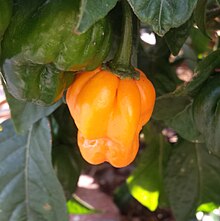| Scotch bonnet | |
|---|---|
 | |
| Species | Capsicum chinense |
| Cultivar | 'Scotch Bonnet' |
| Heat | |
| Scoville scale | 100,000-350,000 SHU |
Scotch bonnet (also known as Bonney peppers, or Caribbean red peppers)[1] is a variety of chili pepper named for its supposed resemblance to a Scottish tam o' shanter bonnet.[2][3] It is ubiquitous in West Africa and the Caribbean.
Like the closely related habanero, Scotch bonnets have a heat rating of 100,000–350,000 Scoville units.[4] For comparison, most jalapeño peppers have a heat rating of 2,500 to 8,000. A completely sweet variety of Scotch bonnet, cachucha, is grown on some Caribbean islands.[citation needed]
Cuisine[edit]
Scotch bonnets are used to flavor many dishes and cuisines worldwide and are often used in hot sauces and condiments. The Scotch bonnet has a sweeter flavor and stouter shape, distinct from its habanero relative with which it is often confused.[citation needed]
Scotch bonnets are mostly used in West Africa, West Indian, Sri Lankan, and Maldivian cuisines and pepper sauces, though they often appear in other Caribbean recipes.[citation needed] Scotch bonnets are used in jerk cooking.[5] They are also used in Nicaragua, Costa Rica and Panama for Caribbean-styled recipes such as rice and peas, rondón, saus, beef patties, and ceviche.[citation needed]
-
Scotch bonnet peppers in a Caribbean market
-
A single ripe Scotch bonnet pepper
See also[edit]
References[edit]
- ^ "Chili Peppers Recipes".
- ^ DeWitt, Dave (1996). Pepper Profile: Scotch Bonnet. Fiery-Foods.com.
- ^ Andrews, Jean (1998). The Pepper Lady's Pocket Pepper Primer. University of Texas Press. p. 147. ISBN 978-0-292-70483-1.
- ^ "Hot Chili Peppers on the Scoville Scale: Measuring chili pepper heat in Scoville units". The Spruce Eats. The Spruce. Archived from the original on 29 May 2018. Retrieved 2008-08-21.
- ^ Cloake, Felicity (2012-07-11). "How to cook perfect jerk chicken". The Guardian. ISSN 0261-3077. Retrieved 2024-01-05.
External links[edit]
 Media related to Scotch Bonnet at Wikimedia Commons
Media related to Scotch Bonnet at Wikimedia Commons


Well, that’s interesting to know that Psilotum nudum are known as whisk ferns. Psilotum nudum is the commoner species of the two. While the P. flaccidum is a rare species and is found in the tropical islands. Both the species are usually epiphytic in habit and grow upon tree ferns. These species may also be terrestrial and grow in humus or in the crevices of the rocks.
View the detailed Guide of Psilotum nudum: Detailed Study Of Psilotum Nudum (Whisk Fern), Classification, Anatomy, Reproduction